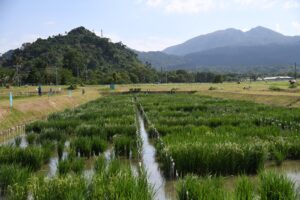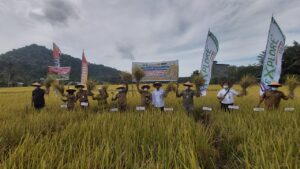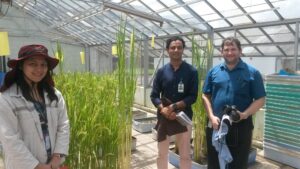
The signs are ominous across West Africa. The price of rice is rising and, consequently, a groundswell of anger is building in several countries in the region where rice is a staple. First in Guinea, then in Senegal, Mali, and Côte d’Ivoire, people have taken to the streets to protest against the rising price of rice. In Burkina Faso, Benin, and Nigeria, housewives, restaurant owners, and tradesmen have started to express their discontent. In Guinea-Bissau, people are directly trading goods for rice.
Alarmed by the protests and the sudden increase in newspaper reports on the price hike, the governments of some of these countries have taken hasty measures to bring down the price of rice.
For instance, in Senegal, the second biggest importer of rice in Africa after Nigeria, the government was forced to reduce the price by 20–25 FCFA (US$0.04–0.05) per kilo in July 2007, after consumers’ associations in the capital Dakar held two major protest marches.
In Côte d’Ivoire, the 8 August 2007 edition of Abidjan’s Nord-Sud newspaper reported that the price of rice had risen by 7–22%. A 25- kilogram bag of “Uncle Sam” rice imported from the United States sold for 6,000 FCFA ($12.50) a month ago and is now selling for 7,000 FCFA ($14.50)—an increase of about 7%. The prices of Vietnamese and Thai rice have gone up by 15% and 22%, respectively.
The article also reported that rice wholesalers in Abidjan attributed this sudden price hike to the fall in world rice supply. “This has led to price speculations that are benefiting only the multinationals,” wholesalers were quoted as saying.
Economists at the Africa Rice Center (WARDA) have long been worried that Africa would find itself engulfed in a major rice crisis if its rice importation policy were not urgently reviewed. Participants at the June 2007 Third Annual Meeting of the Africa Policy Research and Advocacy Group at WARDA, Cotonou, Benin, also expressed deep concern about the current world rice situation and its implications for Africa.
According to the US Department of Agriculture’s Foreign Agricultural Service, world rice reserves, estimated at 80.6 million tons in 2005-06, are at their lowest level since 1983-84. These stocks represent less than 2 months of consumption and half of the stocks are being held by China alone.
World rice consumption continues to outstrip production and the rising prices are expected to double in the next couple of years.
According to the Africa Policy Research and Advocacy Group, established 3 years ago to serve as a channel for transmitting policies to promote the rice sector, the current world rice situation has serious implications for sub-Saharan Africa (SSA) because about 40% of that region’s demand for rice is being met by imports. Further, recent analysis by WARDA economists shows that, in West Africa, this figure is even higher, with rice imports covering up to 67% of demand.

“African national rice economies will increasingly become exposed to unpredictable external supply and price shocks,” WARDA Economist Aliou Diagne said, highlighting the recent warning by the World Bank that the current rise in cereal prices and the low level of global reserves could unleash widespread food riots in Africa.
Referring to the recent measures taken by some African governments against the price hike, WARDA Director General Papa Abdoulaye Seck said, “It is not possible to continue reducing the price of rice artificially without increasing domestic rice production in SSA. Relying on heavy rice imports is less and less a solution for Africa.”
In this context, the recent announcement by three international centers to combine their activities in Africa and so create a powerful new force focused on boosting African rice production has come as a ray of hope for the rice consuming nations of SSA.
The three centers—all of whom are supported by the Consultative Group on International Agricultural Research (CGIAR)—are WARDA, the International Center for Tropical Agriculture (CIAT) based in Colombia, and the International Rice Research Institute (IRRI) based in the Philippines.
In a joint declaration announcing a major programmatic alignment, the three centers affirmed their commitment to bring the best of science and their experience in Asia, Latin America, and Africa to address the major challenges facing Africa’s rice sector.
“By harmonizing our activities, we can cover the whole continent, have a critical mass, address most of the problems facing rice, and at the end of the day we can have a very high impact,” commented Dr. Seck.
Among their initial proposals is the establishment of a sub-Saharan Africa Rice Consortium (SARC), which will consolidate the two existing regional rice networks—the West and Central Africa Rice Research and Development Network and the Eastern and Central Africa Rice Research Network. The new combined entity will also cover other parts of SSA that are not members of the existing regional rice networks.
It was agreed that SARC will offer a platform for collective action by the three international centers and collaboration with national agricultural research and extension systems (NARES). SARC will also provide a united front for promoting rice and rice research in SSA and a common conduit for channeling technology and information from international research to NARES and farmers in the region.
“To me, this is the best way to reach a consensus on rice research in Africa,” said Dr. Seck. “However, this does not mean that excellent research is enough to change Africa’s rice sector,” he cautioned, emphasizing that research can have high impact only if the African countries have adequate infrastructure and a suitable environment in addition to appropriate technologies.
The joint declaration on SARC was made on the basis of the recommendations of the WARDAIRRI-CIAT Programmatic Alignment Planning Meeting, held in June 2007 at WARDA. At the meeting, CGIAR Director Ren Wang (formerly IRRI’s deputy director general for research) hailed the joint initiative as a mark of “concrete progress of the CGIAR centers in moving toward more integration and synergy.”









